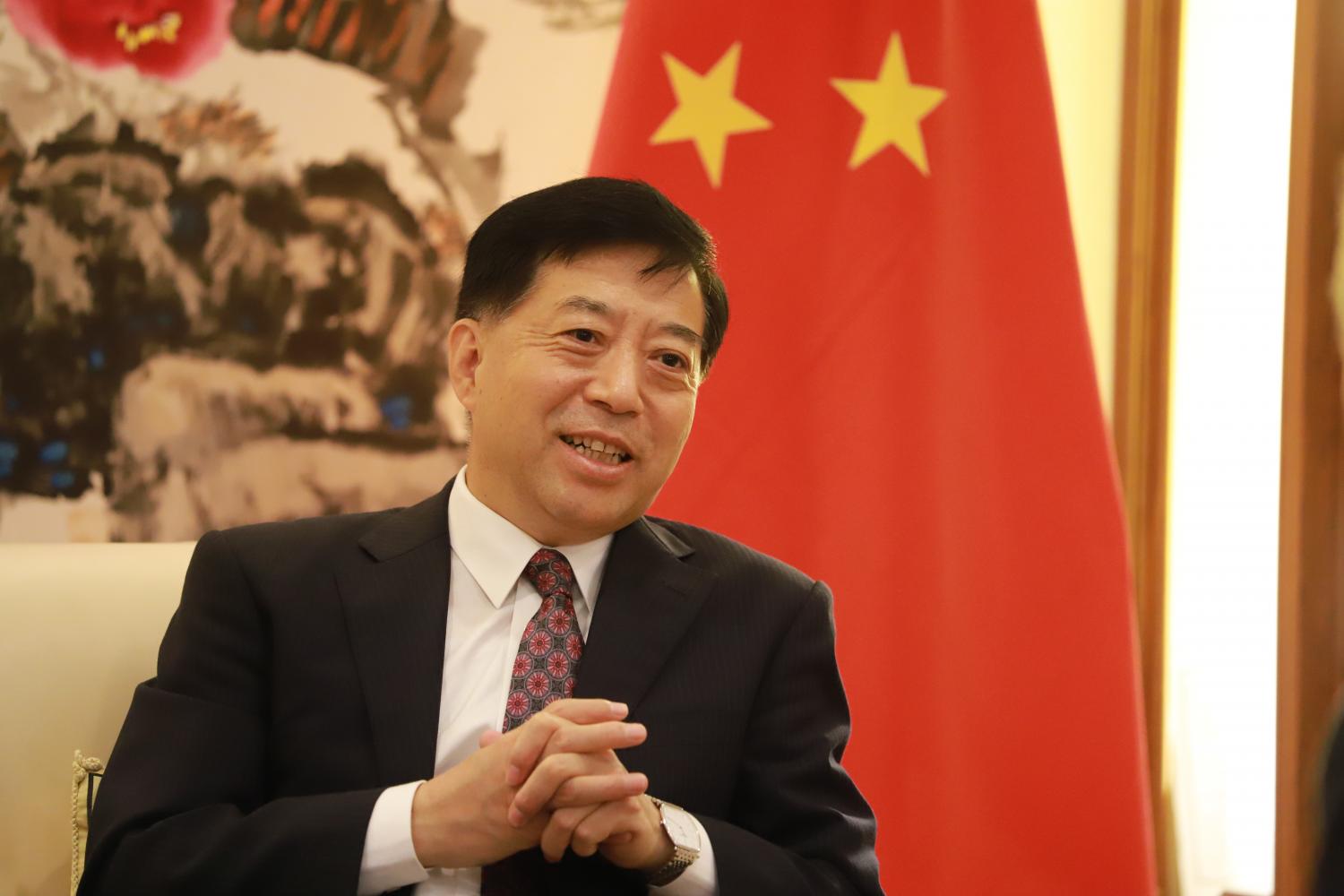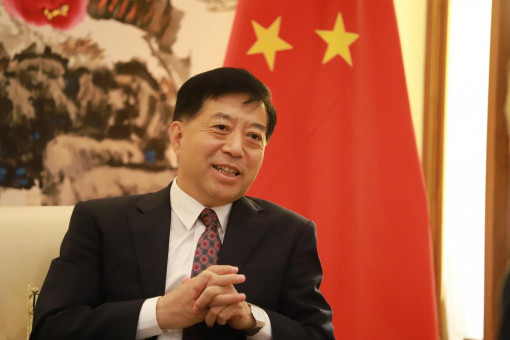
China and Thailand share a close bond, and their cooperation has only strengthened over the years. This year marks 48 years of Thai-Chinese diplomatic relations and yesterday — the National Day of China — marked the 74th anniversary of the founding of the People’s Republic of China.
Han Zhiqiang, China’s Ambassador to Thailand, talks to Bangkok Post’s News Editor, Anucha Charoenpo, about the two countries’ relationship and ties between China and Asean.
This year marks the 48th anniversary of diplomatic relations between China and Thailand, and ties between the two countries have been steadily developing. Could you share your perspective on the status of these ties and your expectations on bilateral relations and practical cooperation between China and Thailand?
China and Thailand are friendly neighbours with shared mountains and rivers, good relatives with shared bloodlines, and good partners in win-win cooperation. Over the 48 years of diplomatic ties, China and Thailand have been moving forward in togetherness, and our good neighbourliness and cooperation has grown ever stronger over time.
China has been Thailand’s largest trading partner for 10 consecutive years. China is also a major export market of agricultural products, and a major source of foreign investment and tourism for Thailand.
The new Thai government led by Prime Minister Srettha Thavisin has just taken office and delivered its policy statement. He has expressed on multiple occasions that he attaches great importance to developing relations with China.
China also extended immediate congratulations to Mr Srettha as prime minister elect. The two sides have been engaging well. Her Royal Highness Princess Sirivannavari Nariratana Rajakanya will go to Hangzhou City, in China’s Zhejiang province, for the Asian Games.
Deputy Prime Minister and Minister of Commerce Phumtham Wechayachai went to Nanning City in Guangxi province for the 20th China-Asean Expo.
Our countries’ foreign ministries are in active communication and preparing for a visit by Prime Minister Srettha to China.
Recently, the government announced a visa exemption policy for Chinese tourists. China welcomes this policy, and expects that Thailand can provide better and safer services for Chinese tourists.
We hope we can seize this opportunity to bring tourism cooperation to a new level.
China is willing to work with the government to implement the outcomes of Chinese President Xi Jinping’s historic visit to Thailand in 2022.
We stand ready to deepen comprehensive strategic cooperation, and maintain political mutual trust. We are willing to develop economic and trade relations especially in the digital economy, green economy and scientific and technological innovation, and make new progress through the “Belt and Road” Initiative (BRI).
We are ready to deepen exchanges in culture and education, enhance friendship and mutual understanding between our peoples, especially young people. We are willing to jointly safeguard regional peace, stability and development, and build the China-Thailand community with a shared future.
What are your expectations regarding the development of ties and mutually beneficial cooperation between China and Asean?
Asean is a regional integration organisation composed of China’s friendly neighbours. China has always prioritised Asean in its neighbourhood diplomacy, and China is committed to developing China-Asean friendly cooperative relations in the spirit of amity, sincerity, mutual benefit and inclusiveness.
In 2013, President Xi Jinping proposed building a closer China-Asean community with a shared future. Building on that in 2021, he proposed building a peaceful, safe and secure, prosperous, beautiful and amicable home that we can share together.
China and Asean elevated their ties to a comprehensive strategic partnership in the same year. This is not only a natural result of the all-round, high-level friendly cooperation between China and Asean, but also a blueprint for the future development of China-Asean relations.
China and Asean have long respected and helped each other, and have been each other’s largest trading partners for three consecutive years. We can proudly say the China-Asean relationship has become the most successful and dynamic model in the Asia-Pacific region.
Looking into the future, China is willing to further build a consensus on cooperation, and strengthen strategic synergy with Asean in order to deliver a higher level of economic integration and interconnected development.
We can work together to create a more prosperous growth centre. We are willing to promote mutually beneficial cooperation between the BRI and the Asean Outlook on the Indo-Pacific.
We are ready to strengthen connectivity and deepen cooperation in industrial and supply chains with Asean, and will strive to conclude negotiations on the China-Asean Free Trade Area 3.0 as early as possible, which will add new momentum and create new advantages for regional development. Together with Asean, China is committed to safeguarding peace, stability and development in the region.
We unswervingly support Asean unity and community building, and firmly support Asean centrality in the regional cooperation architecture. China is willing to join hands with Asean to seize the trend, steer clear of disruptions, share opportunities and create prosperity. Together we can make new steps towards building a closer China-Asean community with a shared future.
Provide an update on progress concerning the BRI. How much progress has been made so far?
Ten years after its inception, the BRI has become the most popular international public good and one of the largest international cooperation platforms. China has signed more than 200 documents on jointly building the BRI with over 150 countries and more than 30 international organisations.
Over 90 bilateral cooperation mechanisms have been set up, and more than 3,000 projects are being implemented, mobilising nearly US$1 trillion in investment, and helping lift almost 40 million people out of poverty. The BRI is bringing tangible benefits to the development of participating countries and the improvement of people’s livelihoods.
Thailand is located at a crucial point of the BRI and is an important participant and beneficiary. The China-Thailand Railway is a flagship project of the BRI. It will significantly improve the condition of Thailand’s railway infrastructure once completed. It will also be connected to the China-Laos Railway, and will bring regional connectivity to a new era.
The third “Belt and Road” Forum for International Cooperation will be held in Beijing this October. We sincerely invite all partners to this event. Looking ahead, China will work with other countries and international organisations, take “hard connectivity” in infrastructure as an important direction, “soft connectivity” in rules and standards as an important support, and “heart connectivity” with the people of partner countries as an important foundation, to make the BRI high-standard, sustainable and people-centred.
Is China concerned that efforts and strategies employed by certain Western countries to contain China in the Indo-Pacific region, which have raised global concerns and heightened vigilance, will affect China’s strategic partnership policies in the region?
It is only natural that the Chinese people strive for a better life and national development through our own hard work. China adheres to peaceful development and pursues a policy of win-win cooperation. China’s development is a positive energy for world peace, stability and prosperity. However, out of selfish purposes, a few countries cannot bear China’s development.
In order to contain China, they even stir up trouble and create conflicts in our region, which jeopardise peace and stability. They use their advantages in the international economic system to launch trade wars and technological blockades, which disrupt global industrial and supply chains, and harm the world economy.
The “Indo-Pacific Strategy” of the United States is actually a policy tool to contain China. What they have done will certainly arouse serious concern and vigilance among countries in the region and even around the world.
There is an ancient Chinese saying that goes: “A just cause enjoys abundant support while an unjust cause finds little support”. One cannot go against the historical trend. China firmly believes that we have the ability to independently realise Chinese modernisation and the great rejuvenation of the Chinese nation.
Any attempt to deprive the Chinese people of their right to pursue a better life or curb China’s development will not succeed. In the end, they will only end up shooting themselves in the foot. This is evidenced in the major scientific and technological progress China has made in recent years. China firmly believes the zero-sum mentality and the winner-takes-all hegemony run counter to the trend of history, to the progress of human society, to people’s aspiration for peace and development in this region and the world.
No matter how it is packaged, no matter how they seduce or coerce, it will only be seen through and cast aside by the countries and people in the region.
President Xi Jinping said in Bangkok last year that countries in our region should uphold international fairness and justice, stay committed to openness and inclusiveness, strive for green and low-carbon development, and bear in mind our shared future, to build an Asia-Pacific of peace and stability, common prosperity, to make it a region that is clean and beautiful, where all are ready to help each other.
China is willing to work with countries in Asia and the Pacific to focus on mutually beneficial cooperation, overcome disruptions and sabotage, so as to build an Asia-Pacific community with a shared future and take Asia-Pacific cooperation to a new height.
How do you look at the current situation regarding China’s economy and can Thailand benefit from China’s economic growth?
Since the beginning of this year, with the sluggish recovery of the world economy as well as the complex and grim external environment, China’s economy has also faced some unfavourable factors, but overall it has continued to recover steadily and maintained a long-term positive trend.
In the first half of the year, China’s GDP grew by 5.5% year-on-year, ranking among the top of world major economies. China’s economy has strong resilience, great potential, and huge vitality. It has bright prospects. We are full of confidence in this.
Now China has entered a new stage of high-quality development. The focus has been shifted from speed to quality. At this stage, the growth rate may stay at 5% to 6% for some time. But if you look at China’s total economic volume which accounts for $18 trillion, the annual increase would still amount to $1 trillion.
At the same time, China has an institutional advantage from a socialist market economy, a demand advantage from a super-scale market, a supply advantage from a complete industrial system, and a talent advantage from a large number of high-quality workers and entrepreneurs. These are all strong guarantees for China’s high-quality economic growth.
China is an important engine of world economic growth.
Over the past 10 years China’s contribution to world annual growth has averaged at more than 30%. The International Monetary Fund projects the same level of contribution this year. China will adhere to a high level of opening up.
We have the confidence and competence to achieve sustained and healthy economic development. We also have the willingness and ability to share development dividends with other countries around the world, especially neighbouring countries such as Thailand.

